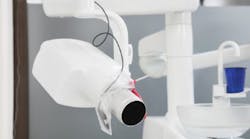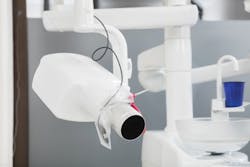Addressing patient refusal, and what to take and when
Kristin Goodfellow, RDH
Imagine this conversation first thing on a Monday morning:
“Hi, Mrs. Jones. My name is Kristin. I am the dental hygienist who will be providing your care today. It is so nice to meet you. Thank you for choosing us as your new dentist!”
“Hi, I hate the dentist. I switched dentists because that other hygienist never listened to me. I have good teeth, and I don’t need x-rays. Plus, you don’t really need x-rays to clean my teeth. Can you just clean them without scraping them?”
Reading this as a dental professional, you are likely already thinking of a patient scenario similar to this one that you have experienced. You’re probably even thinking of the many things that you would say next. Or possibly some things you wouldn’t say but you are definitely thinking.
It isn’t shocking to us that patients don’t really understand what hygienists are trained to do, or the quality care that we can provide. As hygienists, we help set the standard of care in our offices, so we are on the front lines trying to educate patients about the different procedures they need to have done. Some patients make this quite challenging. Especially in this day and age, people are armed with Google and sometimes look to unreliable sources for information. This is especially true when it comes to radiographs. Patients will refuse x-rays for a number of reasons, which we need to identify to reduce their concerns.
Patient refusal can be hard, because you don’t always know quite where someone is coming from. Are patients having financial problems, and afraid they won’t be able to afford the treatment? Is it fear of radiation? Do patients find x-rays to be uncomfortable? Do they have a bad gag reflex? Asking patients why they do not want x-rays taken is very important. Finding out the answer to this simple question can allow you, as an educated dental professional, to address this concern head-on. You can then begin to work together to figure out how to get the films you need to provide the patient with proper care.
© Tyler Olson - Dreamstime.com
Financial concerns: Check the patient’s insurance coverage—necessary films are typically covered. If not, work with the patient. You need to obtain x-rays to provide dental care, and patients come to you because they want that care. Discuss options for future payment. Perhaps your doctor would be willing to do a payment plan for the films.
Fear of radiation: Let your patients know that low levels of radiation exposure are safe. In fact, dental x-rays expose you to less radiation than using your cell phone, fluorescent lamps, microwaves, or computers.
Discomfort/gag reflex: Use tricks and tips recommended by peers. Online hygiene forums are a great place to get tips from others who have had similar experiences. One helpful tip for a bad gag reflex is sprinkling salt on the tongue or using topical sprays and gels to numb the areas. Hopefully having this information in your back pocket can help you get the x-ray images you need.
Taking radiographs is an essential part of patient care and vital to proper diagnoses. Since we can only see about one-third of the tooth in the mouth, without radiographs we are putting ourselves and our offices at risk for some serious legal ramifications. We aren’t just evaluating what we can see; we are also examining all of the hard and soft tissues of the mouth, including bone. We have to create a baseline assessment of care, and radiographs are a part of this. Any new patient in the practice should have a full-mouth series of radiographs. Without these, we are unable to provide competent care. After the initial baseline assessment, if we find no issues, radiographs may not need to be taken as frequently. But this is something we should consider doing at each appointment.
Where many dental professionals get into trouble is taking “blanket” radiographs. This means that regardless of a patient’s oral health status, bitewings are taken every six months. Just because insurance covers it does not mean that you take bitewings at every appointment. It shouldn’t be that patients are due for x-rays because insurance will pay again. It should be that patients are due for x-rays because they have had a cavity in the last 12 months, chew tobacco, or perhaps have active periodontal disease. Frequency of films should be dictated by patient need. If we let insurance coverage dictate care, half of America would likely be toothless.
Patients don’t necessarily have to have active disease to require x-rays at an appointment. Remind your patients that if they have had fillings, crowns, implants, or veneers, that to properly examine those restorations, you and your doctor need to see them on film. Many patients associate painwith the need for films. They think that if they aren’t having any problems, films aren’t necessary. Let your patients know that your goal in taking x-rays is to be proactive, as well as to keep them from feeling any pain or needing additional treatment that can be costly.
Doctors should be a part of these conversations. If you have tried repeatedly without your patients budging, sometimes the doctor can come in and say all the same things you did, and suddenly the patient will smile and accept treatment. While this can be frustrating, you still want your patients to receive the very best care. Films benefit the patient more than they benefit the hygienist or the doctor. X-rays help your patients stay out of pain and keep their teeth.
The bottom line is quality patient care. Obtain a baseline assessment and move forward from there. Allow the status of your patients to help you choose how you care for them in your office. Don’t let Mrs. Jones’ Monday morning objections fluster you.
Kristin Goodfellow, RDH, obtained her Bachelor of Arts in communication studies from West Virginia University. Due to a high interest in the dental field, Kristin decided to enroll in the Allegany College of Maryland’s Dental Hygiene Program, and there she completed her Associate of Science in dental hygiene. At graduation, for her outstanding chairside education, Kristin was chosen by her instructors to receive the Procter & Gamble Excellence in Patient Communication Award. This award recognized her unique combination of skills and inspired her to further herself in her field, utilizing her ability to help patients understand treatment and total body health.








